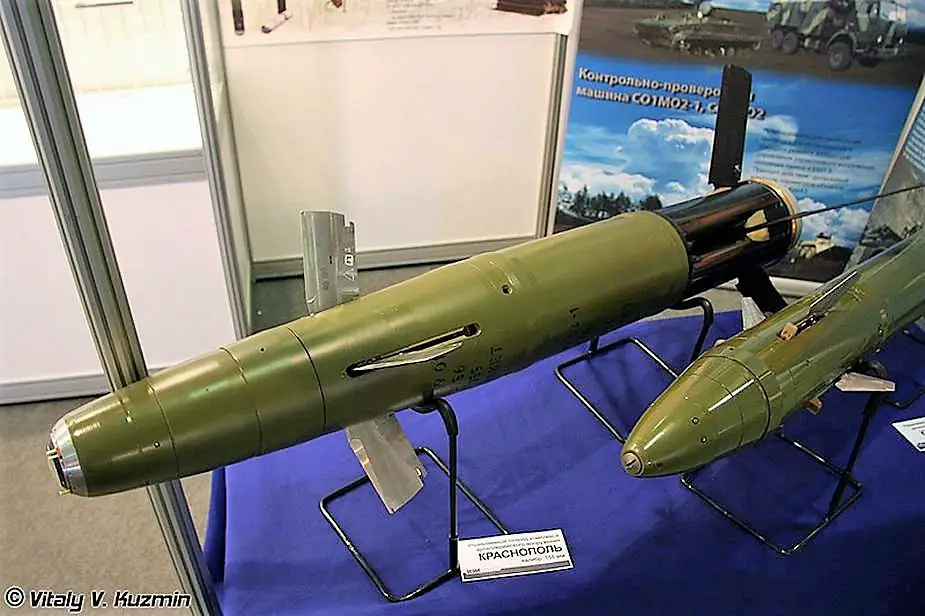Russian army increases stocks of Krasnopol guided artillery shells
The Russian armed forces are receiving various precision weapons. They are supplied to artillery units of the Ground and Airborne Forces. The Krasnopol guided projectile has properly performed in combat, the Army Standard writes, quoted by TASS.
Follow Army Recognition on Google News at this link

Krasnopol guided shells (Picture source: Vitaly Kuzmin)
The Tula Design Bureau has been dealing with guided artillery shells since 1970s. The Krasnopol projectile has a jet engine and a semi-active homing warhead. The 2K25 Krasnopol is a 152/155mm cannon-launched, fin-stabilized, base bleed-assisted, semi-automatic laser-guided, artillery shell. It automatically 'homes' on a point illuminated by a laser designator, typically operated by a ground-based artillery observer. Krasnopol projectiles are fired mainly from self-propelled howitzers such as the 2S3 Akatsiya and 2S19 Msta-S, and intended to engage small ground targets such as tanks, other direct-fire weapons, strong-points, or other significant point targets visible to the observer. It can be used against both stationary and moving targets (providing these remain within the observer's field of view).
The weapon system was developed in the Tula-based KBP Instrument Design Bureau under the supervision of A.G. Shipunov. Work on the project was initiated in the 1970s. In February 1986 the Krasnopol system was adopted by the Soviet Army under the designation 30F39, and began mass production in Izhmash and Izhmeh factories. Since 2002, it is augmented by the 120- and 122 mm Kitolov-2 laser-guided system. A 155 mm variant of the project was also developed to access the commercial markets, which can be fired from howitzers such as the G6 and M109A6. Besides Russia, the Krasnopol is also manufactured by Chinese defense industry conglomerate Norinco.
It was tested in the Afghan war and upgraded in the 1990s according to the experience. The upgraded projectile was tested in the counterterrorist operation in the North Caucasus. In January 2018, it was engaged in the Syrian operation. The guided highly explosive fragmentation projectile has a laser ranger. The pointer guides Krasnopol by a laser beam. The signal comes to the projectile at the end of the flight and the homing warhead adjusts the trajectory to hit the target. It takes close to one minute for the projectile to fly 20 kilometers.
Drones are now replacing the bulky Malakhit portable fire control complex, which weighs 42 kg together with the heat imager and needs three operators. The ground complex can illuminate a tank at a distance of 5-7 km in the daytime and four kilometers at night. The distance to bigger targets is 15 km. Now guidance is provided to the maximum firing range.
Krasnopol destroys stationary objects (firing positions, command posts, warehouses) and moving armored targets (tanks, IFV, APC, antitank missiles). The projectile hits armor driving at a speed of 36 km/h. It is more difficult to destroy a moving object, however, the hit precision is not less than 0.7.
The projectile weighs 51 kg including 6.5 kg of the explosive substance. Krasnopol-M2 guided projectile was designed, as many armies use artillery guns of 155 mm caliber. It can be fired by foreign-made artillery systems.
Designers used Krasnopol's capabilities to create smaller-caliber shells for regimental artillery. The Tula bureau presented Kitolov-2 shell for 120 mm guns, mostly for Nona self-propelled gun. Kitolov-2 is likely to join the round of munitions of Arctic Magnolia gun that is undergoing acceptance trials.
A more powerful Kitolov-2M highly explosive fragmentation projectile was designed for 122 mm guns. Its maximum firing distance is 13.5 km. The warhead weighs 12.25 kg. The hit probability is not less than 0.8.
Guided artillery shells increase mission effectiveness. They decrease the number of engaged guns two to three times and the consumption of shells at least 50 times. The destruction of a platoon stronghold demands 800 ordinary shells, while only 10-12 Krasnopol projectiles are sufficient for the mission. The cost of a combat mission falls 5-10 times.
The upgrade of guided artillery projectiles will continue. Precise guidance equipment is developed, such as autonomous homing warheads, satellite navigation, and effective drones.
Variants
2K25 Krasnopol
The original model of the Krasnopol was designed to be used with former Soviet-bloc artillery systems of 152 mm (6.0 in), such as D-20, 2S3 Akatsiya, 2A65 (Msta-B). Krasnopol carries a 20.5 kg (45 lb) high explosive fragmentation warhead. The entire missile weighs 50 kilograms (110 lb). However, its length made it incompatible with the autoloader of the 2S19 152mm Self-Propelled Gun.
2K25M Krasnopol-M
The Krasnopol-M was a miniaturized version of the projectile, developed in the mid-1990s by Shipunov's team at the KBP Design Bureau taking advantage of new electronics technology acquired in the design of the 120 mm Kitolov-2 guided projectile (similar in construction and purpose; this is, in essence, a smaller model of the Krasnopol to be used with the 2S9 NONA 120 mm mortar and designated 30F69 and a related projectile for 122 mm howitzers designated Kitolov-2M 30F69M) was made with a shorter length to enable it to be used with autoloader-equipped self-propelled guns without having to be disassembled into two parts. It also comes in an alternate 155 mm (6.1 in) caliber to allow it to be used with NATO-standard 155 mm howitzers. Besides the reduced total length, the Krasnopol-M also has a different protective cap for the optical seeker.
KM-1M Krasnopol-M2
The Krasnopol-M2, a further development based on Krasnopol-M, is a 155mm artillery projectile designed to engage armored targets. It uses a semi-active laser (SAL) guidance system in the terminal phase of its trajectory. Kpasnopol-М2 GAP (Guided Artillery Projectiles) was developed to be used with artillery systems such as M109A1-6, G5/G6, FH77, TRF1 among others.
GP1: Chinese version of Krasnopol.
GP6: Chinese version of Krasnopol.




























